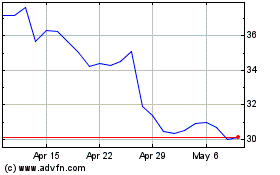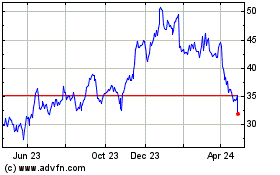Earnings rise 51% as lockdown spurs gain in data-center
business; guidance for year pulled
By Asa Fitch
This article is being republished as part of our daily
reproduction of WSJ.com articles that also appeared in the U.S.
print edition of The Wall Street Journal (April 24, 2020).
Chip maker Intel Corp. reported a jump in first-quarter
earnings, buoyed by sales in its data-center business as the
work-from-home economy spurs demand for computing power, but it
joined many companies in pulling full-year guidance because of
business uncertainty.
The Santa Clara, Calif., company, the U.S.'s largest chip maker,
reported sales of $19.83 billion for the March quarter, a 23%
increase over the same period last year. Earnings per share rose
51% to $1.31.
With the pandemic forcing millions of people to work from home,
Intel said its data-center division, already growing before the
health crisis, saw sales increase 43%. Providers of data centers,
the huge server farms that store data and power the internet, have
been accelerating upgrades and adding hardware, including Intel
processors, to cope with growing demand.
Intel Chief Financial Officer George Davis said the
cloud-computing giants that rent out computing power aren't the
only ones showing increased appetite for its data-center chips, but
also government and corporate buyers.
"We see some of those dynamics continuing in the second half as
well," he said.
Sales in the company's division that includes chips powering
personal computers came in ahead of Intel's expectations, rising
14% as consumers bought machines to work remotely.
A sharp jump in sales of memory chips, also used heavily in data
centers, boosted the first-quarter figures. While Intel's results
topped Wall Street forecasts, its decision to withdraw previously
issued full-year guidance signaled it isn't insulated from the
uncertainty affecting many companies across the U.S.
The coronavirus slump is already hitting Intel's
internet-of-things division, which reported a 3% fall in revenue in
the first quarter, and is likely to affect sales of chips to the
automotive industry, where car sales are expected to drop this
year. PC demand, while strong in the first quarter, may fall off as
consumers' buying power sinks in tandem with global economies.
"We're not entirely immune from these sorts of effects," Mr.
Davis said.
Intel's stock fell more than 5% in after-hours trading.
The company said it expected gross margins in the current
quarter to fall by more than 5 percentage points to 53% -- lower
than analysts had forecast -- on increased production of new,
high-end processors that come with lower margins.
Intel, like others, faces uncertainty over whether the
data-center buying that pushed results higher in the first quarter
will be sustained through the rest of the year. Those sales are
cyclical even in normal times and could falter later this year if
customers decide they don't need extra hardware. Intel is most
anxious about a potential waning in demand from companies and
governments in the latter part of the year, Chief Executive Bob
Swan told analysts.
Another effect of the virus is likely lower capital spending by
Intel this year, Mr. Davis said. That spending now is expected to
come in below the $17 billion the company projected earlier this
year, largely because coronavirus-related shutdowns in some
countries where it operates have stalled construction projects.
The impact would be six to eight weeks of spending that will
likely be pushed further out, he said, adding the company remains
committed to spending on its engineering goals.
Intel is also dealing with stiff competition from rival Advanced
Micro Devices Inc. and lingering manufacturing issues that have
prevented it from taking full advantage of demand spikes for its
personal computer chips. Intel said supply and demand for its
processors were strong in the first quarter.
Although the chip-making giant withdrew its full-year guidance,
it provided a sales outlook for the current quarter of $18.5
billion that came in above the $17.79 billion analysts surveyed by
FactSet were expecting. Like other tech companies, Intel has been
juggling a mixture of costs and benefits from the pandemic but has
held up well relative to many corporate peers.
Intel's results provide the latest indication of how the virus
could hit the bottom lines of high-tech American manufacturers. On
Tuesday, Texas Instruments Inc., a diversified semiconductor
company that is seen as an industry bellwether, reported
better-than-forecast results and said it would keep its factories
running at their current levels to be ready for an economic bounce
when the pandemic subsides.
Nevertheless, analysts have a dim view of semiconductor sales
globally for the full year. Chip revenues will most likely decline
by around 10% this year, said Handel Jones, CEO of consulting firm
International Business Strategies Inc.
Chip makers are dealing with slowed manufacturing in Asia in the
early part of the year, which set back testing and assembly
operations. And with consumers paring back spending in response to
the economic downturn from the virus, global sales of smartphones
and automobiles that had been big markets for the chip industry are
looking anemic.
Intel is expected to do better than many other companies,
though, given its dominant position in data centers.
Others have enjoyed a similar boost. Micron Technology Inc., a
major computer memory maker, last month reported
stronger-than-expected earnings as it shifted its production toward
chips designed for use in data centers. Inphi Corp., a smaller
Santa Clara, Calif.-based supplier of networking hardware to data
centers, on Tuesday said it was expecting better sales because of
demand accelerated by the pandemic.
Write to Asa Fitch at asa.fitch@wsj.com
(END) Dow Jones Newswires
April 24, 2020 02:47 ET (06:47 GMT)
Copyright (c) 2020 Dow Jones & Company, Inc.
Intel (NASDAQ:INTC)
Historical Stock Chart
From Mar 2024 to Apr 2024

Intel (NASDAQ:INTC)
Historical Stock Chart
From Apr 2023 to Apr 2024
